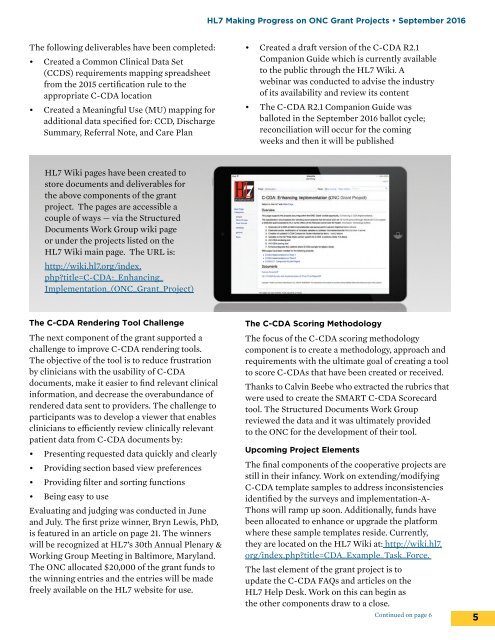In this Issue HL7 News
2cndmS4
2cndmS4
You also want an ePaper? Increase the reach of your titles
YUMPU automatically turns print PDFs into web optimized ePapers that Google loves.
<strong>HL7</strong> Making Progress on ONC Grant Projects • September 2016<br />
The following deliverables have been completed:<br />
• Created a Common Clinical Data Set<br />
(CCDS) requirements mapping spreadsheet<br />
from the 2015 certification rule to the<br />
appropriate C-CDA location<br />
• Created a Meaningful Use (MU) mapping for<br />
additional data specified for: CCD, Discharge<br />
Summary, Referral Note, and Care Plan<br />
• Created a draft version of the C-CDA R2.1<br />
Companion Guide which is currently available<br />
to the public through the <strong>HL7</strong> Wiki. A<br />
webinar was conducted to advise the industry<br />
of its availability and review its content<br />
• The C-CDA R2.1 Companion Guide was<br />
balloted in the September 2016 ballot cycle;<br />
reconciliation will occur for the coming<br />
weeks and then it will be published<br />
<strong>HL7</strong> Wiki pages have been created to<br />
store documents and deliverables for<br />
the above components of the grant<br />
project. The pages are accessible a<br />
couple of ways — via the Structured<br />
Documents Work Group wiki page<br />
or under the projects listed on the<br />
<strong>HL7</strong> Wiki main page. The URL is:<br />
http://wiki.hl7.org/index.<br />
php?title=C-CDA:_Enhancing_<br />
Implementation_(ONC_Grant_Project)<br />
The C-CDA Rendering Tool Challenge<br />
The next component of the grant supported a<br />
challenge to improve C-CDA rendering tools.<br />
The objective of the tool is to reduce frustration<br />
by clinicians with the usability of C-CDA<br />
documents, make it easier to find relevant clinical<br />
information, and decrease the overabundance of<br />
rendered data sent to providers. The challenge to<br />
participants was to develop a viewer that enables<br />
clinicians to efficiently review clinically relevant<br />
patient data from C-CDA documents by:<br />
• Presenting requested data quickly and clearly<br />
• Providing section based view preferences<br />
• Providing filter and sorting functions<br />
• Being easy to use<br />
Evaluating and judging was conducted in June<br />
and July. The first prize winner, Bryn Lewis, PhD,<br />
is featured in an article on page 21. The winners<br />
will be recognized at <strong>HL7</strong>’s 30th Annual Plenary &<br />
Working Group Meeting in Baltimore, Maryland.<br />
The ONC allocated $20,000 of the grant funds to<br />
the winning entries and the entries will be made<br />
freely available on the <strong>HL7</strong> website for use.<br />
The C-CDA Scoring Methodology<br />
The focus of the C-CDA scoring methodology<br />
component is to create a methodology, approach and<br />
requirements with the ultimate goal of creating a tool<br />
to score C-CDAs that have been created or received.<br />
Thanks to Calvin Beebe who extracted the rubrics that<br />
were used to create the SMART C-CDA Scorecard<br />
tool. The Structured Documents Work Group<br />
reviewed the data and it was ultimately provided<br />
to the ONC for the development of their tool.<br />
Upcoming Project Elements<br />
The final components of the cooperative projects are<br />
still in their infancy. Work on extending/modifying<br />
C-CDA template samples to address inconsistencies<br />
identified by the surveys and implementation-A-<br />
Thons will ramp up soon. Additionally, funds have<br />
been allocated to enhance or upgrade the platform<br />
where these sample templates reside. Currently,<br />
they are located on the <strong>HL7</strong> Wiki at: http://wiki.hl7.<br />
org/index.php?title=CDA_Example_Task_Force.<br />
The last element of the grant project is to<br />
update the C-CDA FAQs and articles on the<br />
<strong>HL7</strong> Help Desk. Work on <strong>this</strong> can begin as<br />
the other components draw to a close.<br />
Continued on page 6<br />
5



